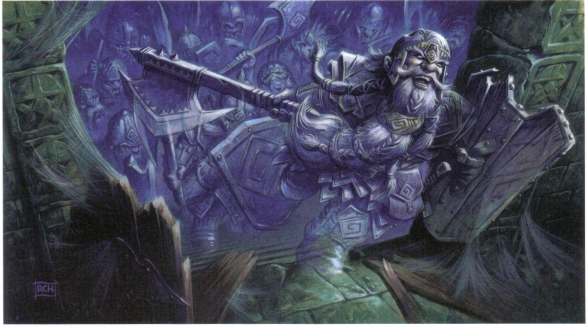Let's Read the 4e Monster Manual 2: Ghost Legionnaire

The first Monster Manual already includes a bunch of ghosts, and it even has a basic Phantom Warrior. Here we have a more specific implementation of that concept.
The Lore
These creatures are the ghosts of soldiers who died in battle more or less at the same time as the entire rest of their units. The emotional bonds between them and the trauma of their violent massed deaths causes their spirits to fuse and to rise as undead.
Legionnaires always appear as a unit, and they look like individuals acting in concert, but they’re all part of the same collective ghost. So it might have been more accurate to title this entry “Ghost Legion”. Members of the legion can possess the living and make them experience the soldiers’ last moments.
When a ghost legionnaire is damaged, it always displays the wounds it suffered in its final battle rather than the ones that were actually inflicted on it. So a squad killed by some wizard’s acid-infused fireball would grow progressively more burned and melted as the PC paladin stabs them.
A ghost legion might be endlessly reliving its last battle when found, seeing any living intruders as their enemies. It might also be following the orders of a more powerful undead being, particularly if that being was one of its commanders in life.
The Numbers
An individual legionnaire is a Medium Natural Humanoid with the Undead keyword, and a Level 13 Soldier with 100 HP. Despite being a ghost, it’s not considered insubstantial, but it has 10 necrotic resistance and isn’t especially vulnerable to radiant damage.
Legionnaires fight with the same weapons they had in life, making devastating cuts with their melee weapons or shooting ghost arrows that do necrotic damage. They can also use their Battle Visions power to possess a target. This has range 20, targets Will and deals psychic damage with a Dominate (save ends) rider. While the target is dominated, the ghost is removed from the map. When the target finally makes their save, the ghost reappears in an adjacent space.
This ghost’s main weakness takes the form of a trait named Call to History. It allows a PC to make a DC 25 History check as a minor action to recall details about the legionnaire’s original unit. A success here makes the PC’s next attack against that ghost deal 10 extra damage. I don’t think you can stack multiple checks in a single attack, but you can make a check every turn before you attack. Someone who was possessed and made their save has a +5 bonus to these tests for the rest of the fight, as those horrifying battle visions act as extra reference material.
The collective nature of a ghost legion is expressed by the Soul Link trait. Basically, you combine the HP totals of all legionnaires present in the fight into a single pool. Damage to any individual legionnaire is subtracted from this combined pool. The whole unit is destroyed when this pool is reduced to 0, but until that happens all legionnaires remain in the fight! This makes the usual “focus fire” strategy considerably less effective against them.
Sample Encounters and Final Impressions
The sample encounter is Level 15, and quite straightforward: a 5-ghost unit and a human lich wizard from the MM. A Nerathi squad plus their former commanding officer.
I really like the “collective HP” gimmick! It shouldn’t be too hard to add or subtract levels from the stat block given here, either, meaning you can bring the Fun (TM) of ghost legions to the party no matter what their level.
There isn’t much of a story difference between a ghost legionnaire and a phantom warrior, as you can see by their names. This suggests that one way to get a level 4 legionnaire would be to remove Insubstantial from the warrior and add Soul Link in its place. You can likely do the same with any other thesaurus buddies that might come along (banshee battlers, figment fighters, spectral soldiers, wraith warriors…).